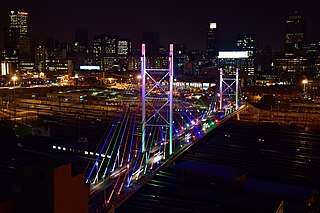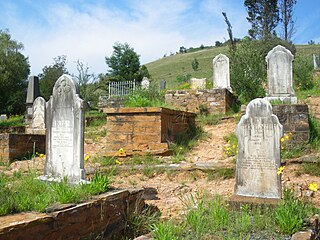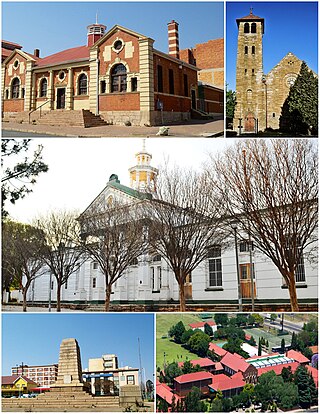
Mafikeng, officially known as Mahikeng and alternatively known as Mafeking, is the capital city of the North West province of South Africa.

Johannesburg, colloquially known as Jozi, Joburg, or "The City of Gold", is the largest city in South Africa, classified as a megacity, and is one of the 100 largest urban areas in the world. According to Demographia, the Johannesburg–Pretoria urban area is the 26th-largest in the world in terms of population, with 14,167,000 inhabitants. It is the provincial capital and largest city of Gauteng, which is the wealthiest province in South Africa. Johannesburg is the seat of the Constitutional Court, the highest court in South Africa. Most of the major South African companies and banks have their head offices in Johannesburg. The city is located in the mineral-rich Witwatersrand range of hills and is the centre of large-scale gold and diamond trade.

Stephanus Johannes Paulus Kruger was a South African politician. He was one of the dominant political and military figures in 19th-century South Africa, and State President of the South African Republic from 1883 to 1900. Nicknamed Oom Paul, he came to international prominence as the face of the Boer cause—that of the Transvaal and its neighbour the Orange Free State—against Britain during the Second Boer War of 1899–1902. He has been called a personification of Afrikanerdom, and remains a controversial figure; admirers venerate him as a tragic folk hero.

Solomon Tshekisho Plaatje was a South African intellectual, journalist, linguist, politician, translator and writer. Plaatje was a founding member and first General Secretary of the South African Native National Congress (SANNC), which became the African National Congress (ANC). The Sol Plaatje Local Municipality, which includes the city of Kimberley, is named after him, as is the Sol Plaatje University in that city, which opened its doors in 2014.

North West is a province of South Africa. Its capital is Mahikeng. The province is located to the west of the major population centre of Gauteng and south of Botswana.

Uitlander, Afrikaans for "foreigner", was a foreign migrant worker during the Witwatersrand Gold Rush in the independent Transvaal Republic following the discovery of gold in 1886. The limited rights granted to this group in the independent Boer Republics was one of the contributing factors behind the Second Boer War.

Johannesburg is a large city in Gauteng Province of South Africa. It was established as a small village controlled by a Health Committee in 1886 with the discovery of an outcrop of a gold reef on the farm Langlaagte. The population of the city grew rapidly, becoming a municipality in 1898. In 1928 it became a city making Johannesburg the largest city in South Africa. In 2002 it joined ten other municipalities to form the City of Johannesburg Metropolitan Municipality. Today, it is a centre for learning and entertainment for all of South Africa. It is also the capital city of Gauteng.

The Witwatersrand Gold Rush was a gold rush that began in 1886 and led to the establishment of Johannesburg, South Africa. It was a part of the Mineral Revolution.

Boksburg is a city on the East Rand (Ekhuruleni) of Gauteng province of South Africa. Gold was discovered in Boksburg in 1887. Boksburg was named after the State Secretary of the South African Republic, W. Eduard Bok. The Main Reef Road linked Boksburg to all the other major mining towns on the Witwatersrand and the Angelo Hotel (1887) was used as a staging post.

Zeerust is a commercial town situated in Ngaka Modiri Molema district North West Province, South Africa. It lies in the Marico valley, approximately 240 kilometres northwest of Johannesburg. It lies on the N4, the main road link between South Africa and Botswana. There are large cattle ranches in the area, as well as wheat, maize, tobacco and citrus fruit farms. There are also fluorite and chromite mines in the vicinity. Tourism is also a developing industry.
The following lists events that happened during 1896 in South Africa.

The military history of Zimbabwe chronicles a vast time period and complex events from the dawn of history until the present time. It covers invasions of native peoples of Africa, encroachment by Europeans, and civil conflict.

Goshen, officially known as the State of Goshen, was a short-lived Boer republic in southern Africa founded by Boers expanding west from Transvaal who opposed British advance in the region.

Mthwakazi is the traditional name of the proto-Ndebele people and Ndebele kingdom and is in the area of today's Zimbabwe. Mthwakazi is widely used to refer to inhabitants of Matebeleland Province in Zimbabwe.
The Minerals Council South Africa is a South African mining-industry employer organisation. Its members include famous South African mining houses such as Anglo American, De Beers, Gold Fields and Harmony. In its current form, it was founded in 1968 as the Chamber of Mines, a South African wide organization. Prior to that year, it has its early origins as the Transvaal Chamber of Mines in 1887, then evolved over many years reforming as the Witwatersrand Chamber of Mines in 1889, the Chamber of Mines of the South African Republic from 1897, Transvaal Chamber of Mines from 1902 and lastly from 1953 until 1967 as the Transvaal and Orange Free State Chamber of Mines. On 23 May 2018, the South African Chamber of Mines rebranded themselves as the Minerals Council South Africa.
Rooigrond is a town in Ngaka Modiri Molema District Municipality in the North West province of South Africa.

Rand Water, previously known as the Rand Water Board, is a South African water utility that supplies potable water to the Gauteng province and other areas of the country and is the largest water utility in Africa. The water is drawn from numerous sources and is purified and supplied to industry, mining and local municipalities and is also involved in sanitation of waste water.

Klipriviersberg Nature Reserve is a nature reserve consisting of veld and koppies (hills) run by the Johannesburg City Parks. It is located 11 kilometres (6.8 mi) south of Johannesburg, in an area of 640 hectares. Home to many species of flora and bird life, it is also home to large and small mammals such as blesbok, zebra, wildebeest and duiker. The reserve has a number of hiking trails and archaeological sites, with the Bloubosspruit flowing through the area.

John Gaspard Gubbins was an Africana collector and writer. He was the son of a rector Richard Shard Gubbins and Ellen Rolls who were married on 21 November 1865.
Jan Eloff was the first civilian commissioner and the second mining commissioner in Johannesburg and the man to whom Eloff Street was named after, the first street to be surveyed. In time, twelve streets in the Greater Johannesburg area were named after him.


















